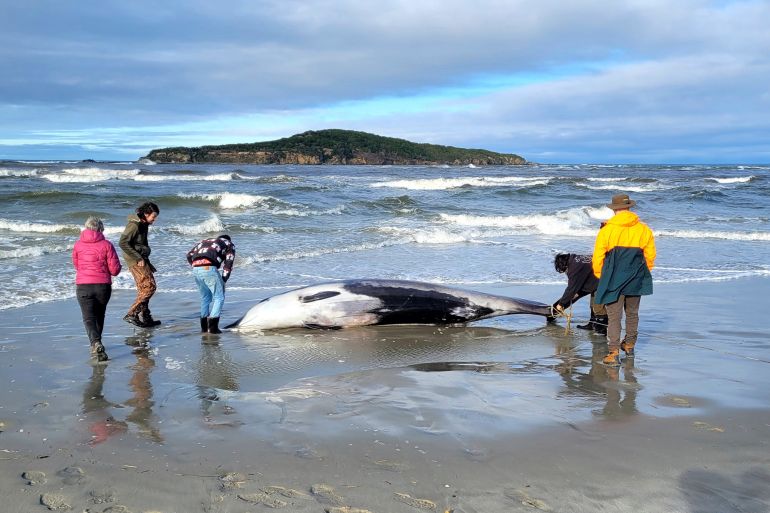Carcass of elusive whale species discovered in New Zealand
Only six samples of the spade-toothed whale have ever been documented.
Rangers inspect what is believed to be a rare spade-toothed whale on July 5, 2024, after it washed ashore on a beach near Otago, New Zealand [New Zealand Department of Conservation via AP]Published On 16 Jul 202416 Jul 2024
The body of a rarely seen whale species appears to have washed ashore on a New Zealand beach, giving scientists new insight into the elusive creature.
The carcass of the spade-toothed whale – which is so rare it has never been spotted alive – was recovered by a river in the southern province of Otago on July 4.
Keep reading
list of 4 itemsend of list
The beaked creature, measuring 5 metres (16.5ft) long, was identified by marine mammal experts at New Zealand’s Department of Conservation and the national museum, Te Papa, as a male spade-toothed whale
A DNA investigation was launched to confirm its classification, scientists said.
The find was fresh enough to offer the first opportunity for researchers to dissect a spade-toothed whale, which scientists know very little about.
“Spade-toothed whales are one of the most poorly known large mammalian species of modern times,” said Gabe Davies, operations manager of the Conservation Department in Otago.
“Since the 1800s, only six samples have ever been documented worldwide, and all but one of these was from New Zealand. From a scientific and conservation point of view, this is huge,” he added.
Because of its rarity, the question of how to handle the finding is one of “international importance”, the Conservation Department said.
Researchers are studying the carcass of the spade-toothed whale that washed up near Taieri Mouth in southern Otago [New Zealand Department of Conservation via AFP]
‘Hitting the jackpot’
The body of the whale has been placed in cold storage and genetic samples sent to the University of Auckland, the curator of the New Zealand Cetacean Tissue Archive.
It may take several weeks or months for the DNA to be processed and a final identification confirmed.
Marine scientist Vanessa Pirotta said researchers will study the whale’s stomach contents, genetics and how this sample compares to previous ones.
This could shine light on the whales’ behaviour, their population and why they are so rare, Pirotta said, describing the discovery as “like hitting the jackpot”.
The species was first described in 1874 from just a lower jaw and two teeth collected from the Chatham Islands off the east coast of New Zealand.
That sample along with skeletal remains of two other specimens found in New Zealand and Chile enabled scientists to confirm a new species.
Because so few specimens have been found and there have been no live sightings, it is classified as “data deficient” under New Zealand’s Threat Classification System.
The first intact specimen was from a mother and calf stranding in the Bay of Plenty in 2010. A further stranding in 2017 in Gisborne added one more specimen to the collection.
New Zealand is a whale-stranding hotspot with more than 5,000 episodes recorded since 1840.
